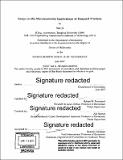Essays on the macroeconomic implications of financial frictions
Author(s)
Ji, Yan, Ph. D. Massachusetts Institute of Technology
DownloadFull printable version (29.80Mb)
Other Contributors
Massachusetts Institute of Technology. Department of Economics.
Advisor
Robert M. Townsend and Alp Simsek.
Terms of use
Metadata
Show full item recordAbstract
This thesis consists of three chapters on the macroeconomic implications of financial frictions. The first chapter investigates the implications of student loan debt on labor market outcomes. I begin by analytically demonstrating that individuals under debt tend to search less and end up with lower-paid jobs. I then develop and estimate a quantitative model with college entry, borrowing, and job search using NLSY97 data to evaluate the proposed mechanism under the fixed repayment plan and the income-based repayment plan (IBR). My simulation suggests that the distortion of debt on job search decisions is large under the fixed repayment plan. IBR alleviates this distortion and improves welfare. In general equilibrium, debt alleviation achieved through IBR effectively offers a tuition subsidy that increases college entry and encourages firms to post more jobs, further improving welfare. The second chapter, joint with Winston Dou, proposes a dynamic corporate model in which firms face imperfect capital markets and frictional product markets. We highlight the importance of the endogeneity of the marginal value of liquidity in determining the interactions between investment, financing and product price setting decisions. The model implies several testable predictions: (1) financially constrained firms are more inclined to increase their desired markups of products; (2) firms facing larger price stickiness tend to issue less external equity and conduct less big payouts; and (3) a large part of the cost from price stickiness is induced by financial frictions. Lastly, we provide stylized facts consistent with our model's predictions. The third chapter (joint with Era Dabla-Norris, Robert Townsend, and Filiz Unsal) develops a general equilibrium model with three dimensions of financial inclusion, depth, and intermediation efficiency. We find that the economic implications of financial inclusion policies vary with the source of frictions. In partial equilibrium, we show analytically that relaxing each of these constraints separately increases GDP. However, when constraints are relaxed jointly, the impacts on the intensive margin (increasing output per entrepreneur with access to credit) are amplified, while the impacts on the extensive margin (promoting credit access) are dampened. In general equilibrium, we discipline the model with firm-level data from six countries and quantitatively evaluate the policy impacts.
Description
Thesis: Ph. D., Massachusetts Institute of Technology, Department of Economics, 2017. Cataloged from PDF version of thesis. Includes bibliographical references (pages 235-248).
Date issued
2017Department
Massachusetts Institute of Technology. Department of EconomicsPublisher
Massachusetts Institute of Technology
Keywords
Economics.